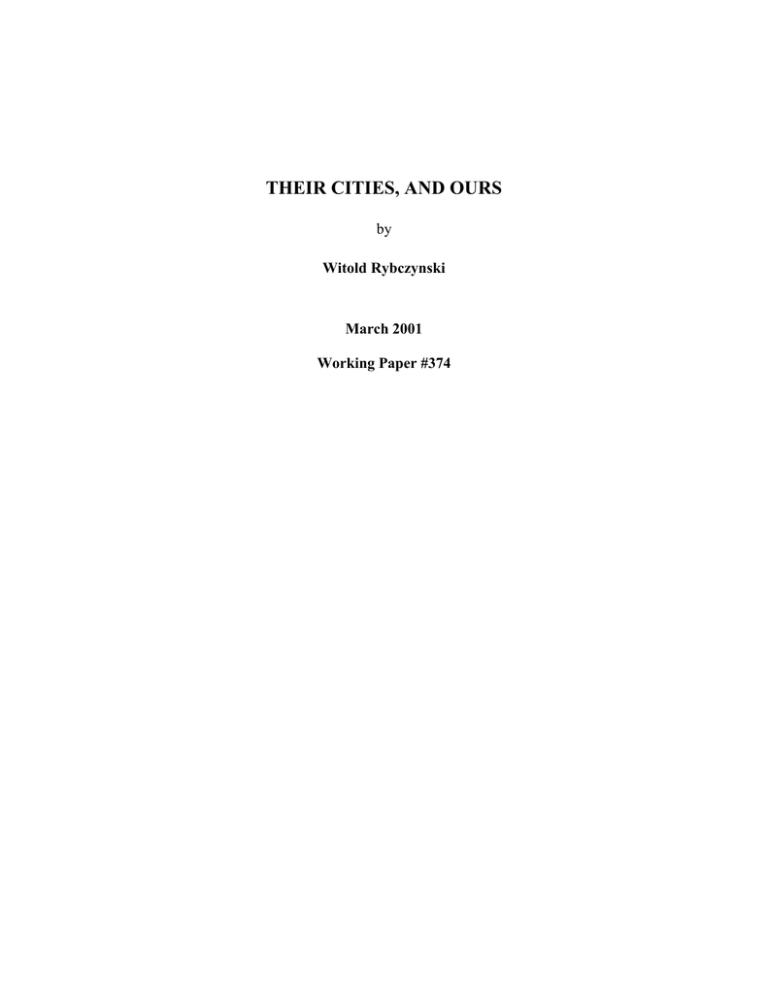THEIR CITIES, AND OURS by Witold Rybczynski
advertisement

THEIR CITIES, AND OURS by Witold Rybczynski March 2001 Working Paper #374 2 Globalization, which has affected so many fields, has arrived in the real estate industry. Large European cities such as London, Frankfurt and Paris have become the site of international real estate investment. Because of the ease of international travel and the effect of international marketing and media, the impression is sometimes given that the cities, too, have become global. After all, the office towers of Canary Wharf and Battery Park City look similar, and their occupants carry similar cell phones, shops at similar stores, and snack at similar fast-food outlets. But the resemblances are superficial-London is not New York City. Cities are shaped by intensely local forces--the availability and ownership of land, transportation, taxation, financing arrangements, and so on. Just as local institutions and customs affect the way that business is conducted in different countries (see "International Real Estate Investing" by Peter Linneman in this issue) so do they also influence the form of cities. Above all, cities are the beneficiaries--and the victims--of national policies. These policies, whether in housing, education, energy, or taxation, have significant if often unintended consequences on the shape of urban development. In Canada, for example, there is no mortgage-interest tax deduction for homeowners, as there is in the United States. So, while the homeownership rate in Canada is similar to that in the U.S., there is no comparable incentive for homeowners to maximize their investment in housing. The results are smaller, less expensive houses, and smaller lots. Which add up to denser cities: for example, Toronto, Canada's largest city, is about twice as dense as Chicago. The way in which national policies have shaped cities has been investigated by Pietro S. Nivola, a senior fellow in governmental studies at the Brookings Institution. Laws of the Landscape, published in 1999, compares American cities with those of Europe, finds that each exhibit particularities, and seeks to explain the differences. First, a look at the differences. Simply put, postwar American cities have sprawled out while European cities have not. There are a number of explanations for this contrasting situation. First, geography: American urban development reflects the fact that the United States is a large country in which vacant land is simply not a scarce commodity. As a result, Chicago has about one-third the number of people per square mile as London, and a city like Houston, which has grown almost exclusively in the automobile-oriented era, has only a fraction of the population density of, say, Moscow (about 5,000 persons/sq.mile vs. 35,000 persons/sq.mile). The United States, like Canada and Australia, has a large land mass. However, it is not simply a question of there simply being room for people to spread out. What drives the horizontal expansion of American cities is not only land availability but demand. Simply put, thanks largely to an openness to external immigration, the U.S. population has grown significantly faster than that of any European nation. In the United States, being "American" is a matter of length of residence and choice; in most European countries, nationality is viewed as a matter of blood. Consequently, between 1950 and 1996, the U. S. population grew by 74 percent, compared with 20 percent in Germany and Italy (despite the immigration of guest-workers from abroad), and only 15 percent in the U.K. So, it is not surprising that European cities have not sprawled out--they have not needed to. In addition to providing homes for immigrants, American cities have had to contend with internal mobility on a scale unknown in Europe. In the postwar period, the demographic--and economic--center of the U.S. moved south and west, greatly increasing 3 the populations of cities such as Atlanta, Houston, Phoenix, and San Diego. Such population movements are unknown in Europe where, except for wartime disruptions, national and even regional differences in laws, government regulations, taxes, social security schemes, and language, have remained significant barriers to mobility. Even in a united Europe it is difficult to imagine tens of millions of Germans and Frenchmen moving permanently to Italy or Spain. The physical layout of cities is affected by the type of housing that they contain., Continental European cities have been characterized by dense arrangements of walk-up and multi-story apartment buildings. Traditionally, these buildings housed a variety of occupants: servants in the basement, upper-class families on the main floor, and lowincome renters in the attic. Such arrangements have rarely been popular in American cities, where since Colonial times the majority of people have preferred to live in individual houses. This cultural preference is shared by the British and the Dutch, but in the U.S. there may also be practical reasons for the single-family house. As Nivola points out, American cities have always been home to large numbers of immigrants, that is, foreigners--people with, at least at first, different customs and ways of life. In 1993, almost 10 percent of the U.S. population was foreign-born, compared to only 2 percent in Italy. That same year, the U.S. had more persons of foreign origin than France, Germany, Italy, Spain, the U.K, and Japan combined (20 million vs. 15 million). Given this heterogeneity, it is understandable that Americans have chosen to spread out rather than live in close proximity to one another. A good deal of sprawl may be a necessary complement to extreme multiculturalism. Technologies have profound impacts on the physical form of cities, and American cities are in a country that throughout the twentieth century has energetically pioneered technological change. This has especially been true in the period before and after World War II, when the wars that wiped out European wealth actually created prosperity. As a result, urban innovations such as steel construction, elevators, electrification, telephones, television, and air conditioning, were either invented in the U.S. or first popularized here. Steel construction and elevators enabled skyscrapers; telephones and television enabled low density suburbs; air conditioning enabled cities in the Sunbelt. The most influential technological development has been, of course, the automobile. More than half of American families owned a car by the mid-1920s, anticipating European ownership levels by forty years. High rates of car-ownership, which produced multi-car families, favored far-flung suburban residential communities, shopping malls, and office parks, and generally disfavored congested downtowns. Equally momentous in its impact on the city was the truck, which drew manufacturing plants and warehouses out of the congested city and into the suburbs. It is likely that given the geographic, demographic, and technological circumstances that attended their growth, American cities in any case would have developed differently than their European counterparts. However, the differences are further explained by different governmental policies. Between 1977 and 1995, all levels of government in the U.S. spent only 14 percent of their transportation budgets on mass transit and Amtrak, the balance going to highways and roads; the British and French regularly spend 40-60 percent of their transportation outlays on mass transit and rail. The American emphasis on automobile transport is likewise reflected in the taxes levied on gasoline, which in 1996 were more than five times lower than in Britain, seven times 4 lower than in Germany, and eight times lower than in the Netherlands. It is hardly surprising that European cities are designed for walking and, in the case of Amsterdam, bicycling. If the middle-class cannot afford cars, it will demand good rail transportation; conversely, if the middle-class can afford cars, it will insist on good highways, and plenty of parking structures. Incidentally, as Nivola points out, the use of automobiles by Americans has little to do with the size of the country--two-thirds of all American car travel is urban, and ninety percent of all trips are less than ten miles. American housing policies likewise differ. Public housing in the U.S. is restricted to the very poor (less than 5 percent of all households) and is usually concentrated in inner city neighborhoods; in most European countries, public housing is available to a wider cross-section, and is generally located in mixed-income districts on the urban periphery. American housing policy has favored ownership and has tended to benefit suburban homeowners rather than urban tenants. The opposite is true in many north European countries (France, Germany, the Netherlands), where frequently subsidized housing is provided by large--often nationalized--employers. American taxation, with its emphasis on income taxes and property taxes, encourages consumption; conversely, European governments tax consumption, which tends to penalize the purchase of cars, gasoline, household goods--and houses. However, it should be noted that homeownership rates in Italy and Ireland are actually higher than in the U.S. and those in Britain are comparable. Two additional national policies affect the physical form of European cities. Most European governments heavily subsidize agriculture. The size of the subsidy is enormous; using the Producer Subsidy Equivalent, it can be shown that in 1995, the average subsidy in the E.U. was more than ten times higher than in the U.S. This has produced high food prices, but it has also kept farmers on their land, which greatly limits the ability of cities to sprawl. The other policy concerns small businesses. France, Italy, and Germany all have laws that effectively support small, family-run businesses and restrict shopping malls, outlet malls, and discounters. The result is a different metropolitan landscape. It is unclear that low density urbanization on the American model is inherently wasteful. After all, as Nivola argues, if Americans are willing to pay for the way that they choose to live, why should that be considered “inefficient” It is true that the social and environmental costs are not always fully reflected in the prices that consumers pay, for infrastructure, for example, or for gasoline. On the other hand, it is possible that there may be a price to pay for the heavy European hand of planned development. Nivola points out that the region of Paris, although it is the most economically dynamic in France, created only 400,000 jobs between 1975 to 1900, while during a comparable period, the New York region, with a population less than twice as large created 1.8 million jobs. The point is not that one form of urbanization is superior to the other. It is difficult to imagine a large, heterogeneous country such as the United States producing a single political, financial, and cultural capital city equivalent to Paris or London. It would have to be a combination of at least New York, Washington, D.C., and Los Angeles, with parts of San Francisco, Seattle, and Chicago thrown in for good measure. Conversely, the massively subsidized and centralized cities of Europe do not lend easily themselves to American forms of urban development, Euro Disney notwithstanding. Globalization is 5 here, no doubt, but the "global city" is a misnomer; cities are--and will remain--intensely parochial creations. [Endnote: A different version of this article first appeared in the New York Review of Books.]





